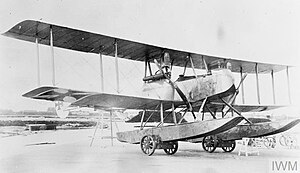
The Mitsubishi F1M was a Japanese reconnaissance floatplane of World War II. It was the last biplane type of the Imperial Japanese Navy, with 944 built between 1936 and 1944. The Navy designation was "Type Zero Observation Seaplane" (零式水上観測機).

The Gotha G.I was a bomber aircraft used by the Luftstreitkräfte during the First World War.

The Friedrichshafen FF.41a was a large, German-built, three-seat, twin-engine floatplane reconnaissance aircraft designed by Flugzeugbau Friedrichshafen in 1917.

The Hansa-Brandenburg W.29 was a German two-seat fighter floatplane which served in the closing months of World War I with the Imperial German Navy's Naval Air Service from bases on the North Sea coast. In concept the aircraft was a monoplane version of the biplane Hansa-Brandenburg W.12, although there were many structural differences between the two.
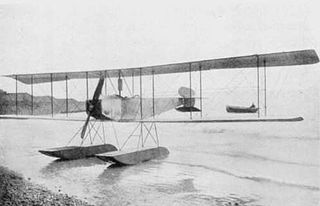
The Avro Type H, Type 501, and Type 503 were a family of early British military seaplanes. They were a development of the Avro 500 design and were originally conceived of as amphibious, the prototype being fitted with a single large main float under the fuselage, and two outrigger floats under the wings.

The Friedrichshafen FF.29 was an unarmed maritime reconnaissance floatplane built for the Imperial German Navy's Naval Air Service that was produced by Flugzeugbau Friedrichshafen during World War I. The aircraft entered service in November 1914, mostly conducting maritime patrols over the North Sea and the English Channel, and played a small role in the Raid on Cuxhaven the following month. A FF.29 became the first aircraft to be transported by a submarine when it was used in experiments in January 1915. In May an emergency landing by a FF.29 was the cause of the action off Noordhinder Bank when German forces were searching for the floatplane when they encountered a superior British force. The aircraft was also involved in developing methods of controlling artillery fire from the air.

The Friedrichshafen FF.35 was a German three-seat floatplane torpedo bomber built during World War I by Friedrichshafen Flugzeugbau built for the Imperial German Navy's Naval Air Service. Only one prototype was constructed in 1916 and it saw limited operational use during the war in Courland.

The Gotha G.VII was a bomber aircraft produced in Germany during the final months of World War I. With the strategic bombing campaign effectively over, it was intended to be a high-speed tactical bomber with a secondary reconnaissance capability.
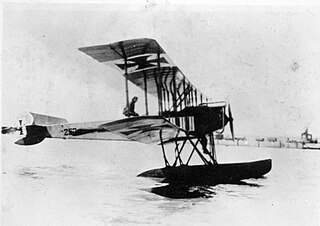
The Gotha WD.2 and its derivatives were a family of military reconnaissance aircraft produced in Germany just before and during the early part of World War I.
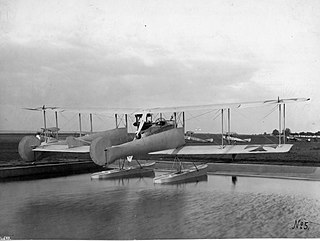
The Gotha WD.3 was a prototype maritime reconnaissance floatplane developed during World War I by Gothaer Waggonfabrik (Gotha) for the Imperial German Navy's Naval Air Service. The three-seat aircraft used the pusher configuration with the engine behind the crew. It was lacking in performance compared to aircraft with the more common tractor configuration with the engine in the nose and was not approved for production. The single prototype completed was used as a training aircraft; its ultimate fate is unknown.
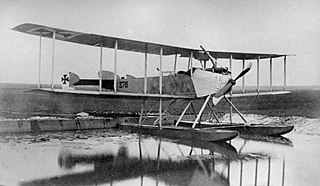
The Gotha WD.8 was a single-engine maritime patrol floatplane developed during World War I by Gothaer Waggonfabrik for the Imperial German Navy's Naval Air Service. The WD.8 was a single-engine version of the WD.7 developed for comparative purposes. The single prototype built was deemed "totally unsuitable" by the Naval Air Service and was later sold to the Ottoman Empire.

The Gotha WD.11 was a three-seat floatplane torpedo-bomber developed during World War I by Gothaer Waggonfabrik (Gotha) for the Imperial German Navy's Naval Air Service. The company's earlier Gotha WD.7 had been moderately successful as a training aircraft for torpedo tactics and it designed a larger and more powerful aircraft along the same general lines. The prototype was completed in 1916 and the aircraft entered service the following year. 17 examples were built and enjoyed limited success, sinking two British freighters in the North Sea. One squadron participated in Operation Albion in 1917 with limited effectiveness. Torpedo shortages and durability issues forced the WD.11s removal from active service in 1918. Fewer than half survived to be inventoried by the Allies after the war.

The Gotha WD.14, WD.20, and WD.22 were a family of biplane torpedo bomber floatplanes developed in Germany during World War I.
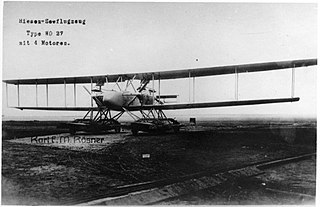
The Gotha WD.27 was a long-range maritime patrol floatplane developed during World War I by Gothaer Waggonfabrik (Gotha) for the Imperial German Navy's Naval Air Service. It was a large, four-engine aircraft with the same general layout as the WD.22; a conventional floatplane with engines grouped in tractor-pusher pairs on the lower wings. Three aircraft were ordered in early 1918, but the first prototype was not completed until after the end of the war in November. It may not have flown before it was ordered to be destroyed by the victorious Allies.

The LFG Roland D.I was a fighter aircraft produced in Germany during World War I. It was a single-seat aircraft based originally on the Roland C.II two-seat reconnaissance type. It shared its predecessor's unusual design feature of having a deep fuselage that completely filled the interplane gap, but in comparison, the fuselage was much sleeker. While the C.II's appearance had earned the Walfisch ("Whale"), the D.I became known as the Haifisch ("Shark"). The I-struts that had been used to brace the C.II's wing were replaced by more conventional struts. Other changes to the wing included the removal of stagger from the design and the introduction of slight sweepback.
The Gotha G.VI was an experimental bomber aircraft designed and built in Germany during World War I.
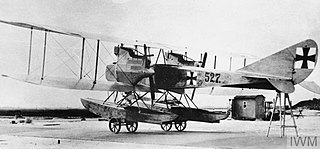
The Albatros W.3, company designation VT, was a biplane torpedo bomber floatplane prototype, built for the Imperial German Navy during the First World War. Only one was built.
The Gotha B types of the Gothaer Waggonfabrik were two-seat reconnaissance/trainer aircraft of the German Air Force in the First World War.

The Friedrichshafen D.I was a German single-seat fighter plane developed by the Flugzeugbau Friedrichshafen during the First World War. Two prototypes were flown in 1917, but it was judged inferior to the Albatros D.III then in production and no further production ensued.
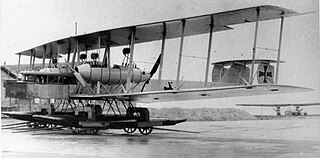
The Zeppelin-Staaken L was an experimental long-range maritime patrol floatplane developed during World War I by Zeppelin-Staaken for the Imperial German Navy's Naval Air Service. Derived from the Zeppelin-Staaken R.VI heavy bomber, it was a large, four-engine aircraft with its engines grouped in tractor-pusher pairs between the wings. A single aircraft was ordered for evaluation purposes in 1917. Six improved versions were ordered while the L was being tested. It was destroyed in a crash in June 1918 with the death of everyone aboard.
